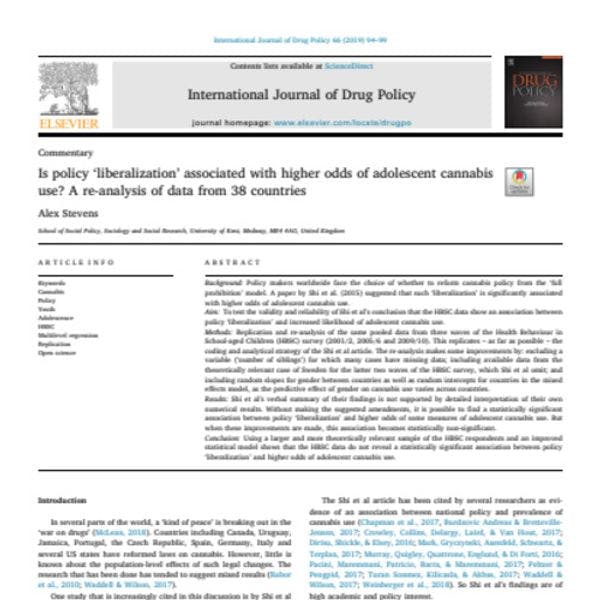« Libéralisation » des politiques des drogues : associée à une probabilité accrue d'usage des drogues par les adolescents ?
Alex Stevens suggère que l'impact des réformes sur l'usage des adolescent a été sur-estimé. Pour en savoir plus, en anglais, veuillez lire les informations ci-dessous.
Abstract
Background
Policy makers worldwide face the choice of whether to reform cannabis policy from the ‘full prohibition’ model. A paper by Shi et al. (2015) suggested that such ‘liberalization’ is significantly associated with higher odds of adolescent cannabis use.
Aim
To test the validity and reliability of Shi et al’s conclusion that the HBSC data show an association between policy ‘liberalization’ and increased likelihood of adolescent cannabis use.
Methods
Replication and re-analysis of the same pooled data from three waves of the Health Behaviour in School-aged Children (HBSC) survey (2001/2, 2005/6 and 2009/10). This replicates – as far as possible – the coding and analytical strategy of the Shi et al article. The re-analysis makes some improvements by: excluding a variable (‘number of siblings’) for which many cases have missing data; including available data from the theoretically relevant case of Sweden for the latter two waves of the HBSC survey, which Shi et al omit; and including random slopes for gender between countries as well as random intercepts for countries in the mixed effects model, as the predictive effect of gender on cannabis use varies across countries.
Results
Shi et al’s verbal summary of their findings is not supported by detailed interpretation of their own numerical results. Without making the suggested amendments, it is possible to find a statistically significant association between policy ‘liberalization’ and higher odds of some measures of adolescent cannabis use. But when these improvements are made, this association becomes statistically non-significant.
Conclusion
Using a larger and more theoretically relevant sample of the HBSC respondents and an improved statistical model shows that the HBSC data do not reveal a statistically significant association between policy ‘liberalization’ and higher odds of adolescent cannabis use.
